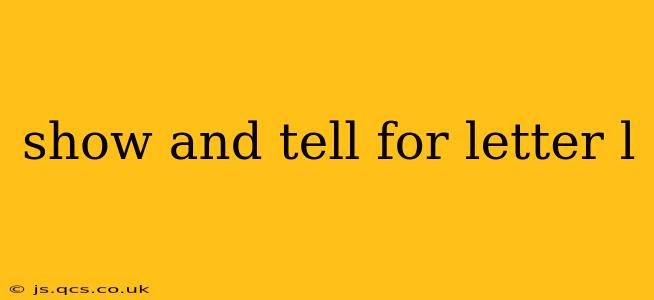Learning the alphabet can be an exciting adventure, especially when it's interactive and engaging! This guide provides a comprehensive approach to teaching the letter L through a "show and tell" method, perfect for preschoolers, kindergartners, and even early elementary students. We'll cover various activities, incorporate different learning styles, and address common questions parents and educators might have.
What are some things that start with the letter L?
This is a crucial starting point for any "show and tell" activity. Brainstorming objects beginning with "L" helps children connect the letter to real-world objects. Examples include:
- Lion: Show a picture of a lion, a stuffed lion toy, or even a roaring lion sound effect. Discuss the lion's characteristics – its mane, roar, and habitat.
- Lemon: Bring in a real lemon (or a picture), and let the children smell and (carefully) touch it. Talk about its sour taste and its use in lemonade or baking.
- Leaf: Collect various leaves from outside – different shapes, sizes, and colors. Compare and contrast them. Discuss the importance of leaves for trees.
- Ladder: Show a picture of a ladder and discuss its function – helping us reach high places. You can even create a small, safe ladder using blocks.
- Lollypop: (Use discretion based on your setting) If appropriate, a lollypop can be a fun, engaging example, but emphasize responsible candy consumption.
How do you make the letter L sound?
This section focuses on phonics and pronunciation.
- Sound it out: Emphasize the sound the letter L makes by repeatedly saying "L-L-L" and having the children repeat after you.
- Say words with L: Practice saying simple words that start with L, such as "lion," "lemon," and "lamp." Gradually introduce more complex words containing the letter L in different positions (e.g., "table," "yellow," "school").
- Listen for the sound: Play a game where you say several words, and the children raise their hand when they hear a word starting with L.
What are some fun activities to teach the letter L?
Here are some engaging activities to reinforce letter recognition and sound association:
- L-shaped crafts: Use playdough to create the letter L, or have children trace and color large L shapes.
- Letter tracing: Use sandpaper letters, textured paint, or finger paints for a sensory experience while tracing the letter L.
- L-themed coloring pages: Print out coloring pages featuring objects starting with L.
- Create an L collage: Gather pictures of objects beginning with L and create a collage.
- "L" is for... Game: Start the phrase "L is for..." and encourage children to complete it with an object beginning with the letter L.
What are some things that start with a capital L?
This section helps children differentiate between uppercase and lowercase letters.
- Use names: Mention names beginning with L (like Liam, Lucy, or Lola), emphasizing the capital L at the beginning.
- Label objects: Label objects around the classroom with their names, highlighting the capital letters.
- Capital and lowercase comparison: Show both uppercase and lowercase L side by side, pointing out their differences in size and shape.
How can I make learning the letter L fun and engaging for my child?
The key is to keep it playful and relatable. Incorporate the child's interests, use different learning styles, and offer a variety of activities. Remember to praise effort and celebrate successes, fostering a positive learning environment.
By using a multi-sensory and interactive "show and tell" approach, you can make learning the letter L a memorable and enjoyable experience for your child. Remember to tailor the activities to your child's age and developmental stage, adjusting the complexity and duration as needed. The goal is to build a strong foundation for literacy development in a fun and engaging way.
